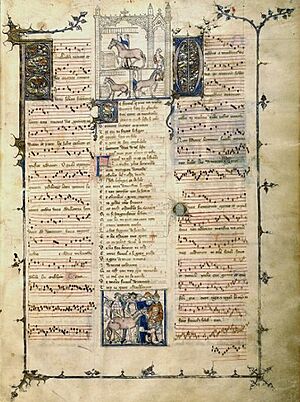Ars nova facts for kids
Ars nova (which means "new art" in Latin) was a popular style of music in France during the Late Middle Ages. This period usually refers to the time between the early 1310s, when the book Roman de Fauvel was created, and the death of a famous composer named Guillaume de Machaut in 1377. Sometimes, the term "Ars nova" is used more broadly to describe all European music with multiple voices (called polyphony) from the 1300s.
The word "ars" in "Ars nova" can mean "technique" or "style." This term first appeared in two music books: Ars novae musicae (New Technique of Music) around 1320, written by Johannes de Muris, and another collection of writings from about 1322, often linked to Philippe de Vitry. Later, in 1904, a music expert named Johannes Wolf started using "Ars nova" to describe this whole musical era.
The term "Ars nova" is often compared to "ars antiqua" (old art). "Ars antiqua" refers to the music that came just before, usually from about 1170 to 1320, including music from the Notre Dame school. So, generally, "Ars antiqua" describes 1200s music, and "Ars nova" describes 1300s music.
The period after Machaut's death in 1377, up to the early 1400s, included even more complex rhythms in a style called "ars subtilior." Some people see this as the very end of the "Ars nova" period, while others consider it a separate time in music history.
How Ars Nova Music Was Different
The music of the Ars nova period was quite different from the music that came before it. Here's how:
- New Ways to Write Music: Musicians developed better ways to write down notes. This allowed them to create more independent and varied rhythms. Before, music was often limited by simpler rhythmic patterns.
- Secular Music Grew: Music that wasn't for church (called secular music) became much more complex. It started to have the same kind of detailed multi-voice arrangements that used to be only in sacred church music.
- New Techniques: Composers started using new methods and forms, like isorhythm. This is a technique where a rhythmic pattern and a melodic pattern are repeated, but they don't always line up in the same way.
- More Expressive: All these changes made the music sound much more expressive and varied than before. It was a big leap forward in how music could sound and feel.
This sudden change in music, with its new level of expression, was similar to how painting changed during the Renaissance with the invention of perspective. It was a time of great artistic revolution.
The most famous composer of the Ars nova style was Guillaume de Machaut. He was also a respected poet and worked at Reims Cathedral. His many musical works, including motets, lais, virelais, rondeaux, and ballades, show off the Ars nova style.
Towards the end of the 1300s, a new group of composers and poets emerged in Avignon, France. Their music was very detailed and complex, often called the "ars subtilior" (more subtle art). Some experts see this as a late part of Ars nova, while others consider it a separate style. This unique music was mostly found in southern France, Aragon, and Cyprus. It was likely made for skilled musicians to play for audiences who really understood music.
Important Ars Nova Composers
Here are some of the key composers from the Ars nova period:
| Name | When They Lived | Surviving Works | Ref(s) |
|---|---|---|---|
| Philippe de Vitry | 1291–1361 | Many works | |
| Jehan de Lescurel | Active in the early 1300s | Many ballades and rondeaus; two "Diz entez" | |
| Guillaume de Machaut | Around 1300 – 1377 | Many pieces in different forms
|
|
| P. des Molins | Active in the mid-1300s | The ballade De ce que fol pensé and the rondeau Amis, tout dous vis | |
| Jehan Vaillant | Active 1360–1390 | Three rondeaus, a ballade, and virelais
|
|
| Grimace | Active mid-to-late 1300s | Three ballades, a virelai, and rondeau
|
|
| F. Andrieu | Active late 1300s | The double ballade Armes amours | |
| Briquet | Active early 1400s | The rondeau Ma seule amour et ma belle maistresse |
Recordings of Ars Nova Music
You can listen to Ars nova music on these recordings:
- Chants du XIVème siècle. Performed by Mora Vocis Ensemble.
- Denkmäler alter Musik aus dem Codex Reina (14./15. Jh.). Performed by Syntagma Musicum.
- Domna. Performed by Esther Lamandier.
- La fontaine amoureuse: Poetry and Music of Guillaume de Machaut. Performed by Music for a While.
- Guillaume de Machaut. Je, Guillaumes Dessus Nommez. Performed by Ensemble Gilles Binchois.
- Guillaume de Machaut. La Messe de Nostre Dame und Motetten. Performed by Capella Antiqua München.
- Guillaume de Machaut. La messe de Nostre Dame; Le voir dit. Performed by Oxford Camerata.
- Guillaume de Machaut. Messe de Notre Dame. Performed by Ensemble Organum.
- Guillaume de Machaut. Messe de Notre Dame; Le lai de la fonteinne; Ma fin est mon commencement. Performed by Hilliard Ensemble.
- Guillaume de Machaut. Motets. Performed by Hilliard Ensemble.
- Philippe De Vitry and the Ars Nova—Motets. Performed by Orlando Consort.
- Philippe de Vitry. Motets & Chansons. Performed by Sequentia.
- Roman de Fauvel. Performed by Studio der Frühen Musik.
- Le roman de Fauvel. Performed by Anne Azéma, Dominique Visse, Boston Camerata, and Ensemble Project Ars Nova.
- The Service of Venus and Mars: Music for the Knights of the Garter, 1340–1440. Performed by Gothic Voices.
- The Spirit of England and France I: Music of the Late Middle Ages for Court and Church. Performed by Gothic Voices.
- The Study of Love: French Songs and Motets of the 14th Century. Performed by Gothic Voices.


